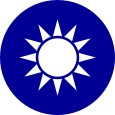
Back الوضع السياسي في تايوان Arabic Estatus políticu de Taiwán AST Taiwan-Konflikt German Estatus político de la República de China Spanish وضعیت سیاسی تایوان Persian Statut de Taïwan French מעמדה הבין-לאומי של טאיוואן HE Status politik Taiwan ID Status politico di Taiwan Italian 台湾問題 Japanese
| Taiwan issue | |||||||||||||||||||||||||
|---|---|---|---|---|---|---|---|---|---|---|---|---|---|---|---|---|---|---|---|---|---|---|---|---|---|
| Traditional Chinese | 臺灣問題 | ||||||||||||||||||||||||
| Simplified Chinese | 台湾问题 | ||||||||||||||||||||||||
| Literal meaning | The Taiwan issue | ||||||||||||||||||||||||
| |||||||||||||||||||||||||
 |
|---|
|
|
 |
|---|
|
|
The political status of Taiwan or the Taiwan issue is an ongoing geopolitical dispute about Taiwan, currently controlled by the Republic of China (ROC), that arose in the mid-twentieth century. Originally based in mainland China before and during World War II, the ROC government retreated to Taiwan in 1949 after it was defeated by the Chinese Communist Party (CCP) during the Chinese Civil War and the subsequent establishment of the People's Republic of China (PRC). Since then, the effective jurisdiction of the ROC has been limited to Taiwan, Penghu, Kinmen, Matsu, and smaller islands.
The surrender of Japan in 1945 brought an end to the Japanese rule of these islands and restored them under Chinese administration as intended by the major Allies of World War II. Due to the rivalry between the ROC and the PRC, post-war agreements did not specify the owner of the islands.[1][2] The ROC constitution still claims both mainland China and Taiwan as its territory; it no longer considers the CCP as a rebellious group but admits it as the "mainland authorities".[3] The PRC claims Taiwan as a Chinese province[4] and has not ruled out the use of military force in the pursuit of Chinese unification.[5] It has proposed "one country, two systems" as a model for unification, though this has been rejected by the Taiwanese government.[6] Within Taiwan, there is major political contention between eventual Chinese unification with a pan-Chinese identity contrasted with formal independence promoting a Taiwanese identity, though moderates supporting the status quo have gained broad appeal in the 21st century.[7][8]
Since 1949 many countries must choose between the PRC and the ROC with which to establish formal diplomatic relations and shape their respective "One China" policy. Initially excluded from the United Nations in favor of Taipei, Beijing has gained increased recognition as the legitimate government of China. The ROC has formal diplomatic relations with only twelve nations but maintains unofficial bilateral ties and membership in international organizations as a non-state entity.[9]
- ^ "MOFA reaffirms ROC sovereignty over Taiwan, Penghu". 5 September 2011.
- ^ HC Deb 26 July 1950 vol 478 c60W. "Formosa is still de jure Japanese territory and there is no Government of Formosa as such. Following on the surrender of Japan, the Chinese Government of the day assumed, with the consent of the remaining Allies, the provisional administration of the territory pending the final determination of its status at a peace settlement."
- ^ Han Cheung (25 April 2021). "Taiwan in Time: The 'communist rebellion' finally ends". Taipei Times. Archived from the original on 22 October 2021. Retrieved 2 July 2022.
...Most importantly, with the repeal of the temporary provisions, the Chinese Communist Party would no longer be seen as a rebel group. "From now on, we will see the Chinese Communist Party as a political entity that controls the mainland region and we will call them the 'mainland authorities' or the 'Chinese Communist authorities'," President Lee said during the press conference
- ^ Fabry, Mikulas (2 January 2024). "The Effect of 'One China' Policies of Foreign States on the International Status of Taiwan". Diplomacy & Statecraft. 35 (1): 90–115. doi:10.1080/09592296.2024.2303855.
In contrast, the 2005 law designed to forestall Taiwanese 'secession' ... left out the third part. This formulation, reiterated in the 2022 PRC white paper on Taiwan ...
- ^ "Archived copy" (PDF). Archived (PDF) from the original on 24 January 2020. Retrieved 19 November 2019.
{{cite web}}: CS1 maint: archived copy as title (link) - ^ "Taiwan leader rejects China's 'one country, two systems' offer". Reuters. 10 October 2019. Archived from the original on 6 October 2023. Retrieved 21 September 2023.
- ^ Fell, Dafydd (2006). Party Politics in Taiwan. Routledge. p. 85. ISBN 978-1-134-24021-0.
- ^ Achen, Christopher H.; Wang, T. Y. (2017). "The Taiwan Voter: An Introduction". In Achen, Christopher H.; Wang, T. Y. (eds.). The Taiwan Voter. University of Michigan Press. pp. 1–25. doi:10.3998/mpub.9375036. ISBN 978-0-472-07353-5. pp. 1–2.
- ^ Chong, Ja Ian (9 February 2023). "The Many "One Chinas": Multiple Approaches to Taiwan and China". Carnegie Endowment for International Peace. Archived from the original on 3 May 2023. Retrieved 6 May 2023.
